Well that’s a wonderful start.
JP's Blog
A Radical Act of Free Magic The Shadow Histories #2
A Radical Act of Free Magic takes place right where A Declaration of the Rights of Magicians leaves off. The French Revolution is well underway, Britain might very well be next, slaves are revolting, and there’s this mysterious shadow operating behind the scenes…
Add to that: Napoleon! Even more magic! Magical beasties a la a kraken and a dragon! ! And EVEN MORE POLITICS.
Foundryside The Founders Trilogy #1
Every innovation—technological, sociological, or otherwise—begins as a crusade, organizes itself into a practical business, and then, over time, degrades into common exploitation. This is simply the life cycle of how human ingenuity manifests in the material world. What goes forgotten, though, is that those who partake in this system undergo a similar transformation: people begin as comrades and fellow citizens, then become labor resources and assets, and then, as their utility shifts or degrades, transmute into liabilities, and thus must be appropriately managed.
Well that was delightful. It’s been on my list for a while, so I figured I’d give it a chance and I’m so very glad I did.
I highly recommend the book, with the disclaimer that there are some dark scenes, bits (sorry) of body horror, and quite a lot of (made up fantasy) swearing.
The Lost Metal Mistborn #7 Mistborn Era 2 #4 The Cosmere *
Mate, it ain’t violence if it’s religion.
And so it ends. The second era of one of the more ambitious ideas in fantasy: take a fantasy world with a hard/scientific magic system (or three), tell a crazy story in that world, and then advance a few hundred years so that the first story becomes the myths and religions of the world. Not only that, but (specifically in the Lost Metal), take that same idea and expand it across a shared universe of fantasy worlds, each with their own feel and magic and start really bringing things in from other worlds, mashing them together and seeing just what sort of madness pops out.
The Unwritten, Vol. 11: Apocalypse The Unwritten #11
It all comes together in the end. Pullman. Madame Puppeteer. Tom and Tommy. Savoy, Wilson, Lizzie. The Rabbit. Everyone.
And of course, for the biggest story: the Grail (and the other stories based on it and based upon it). Or is it a drum? A trumpet? The Trumpet?
And… the End.
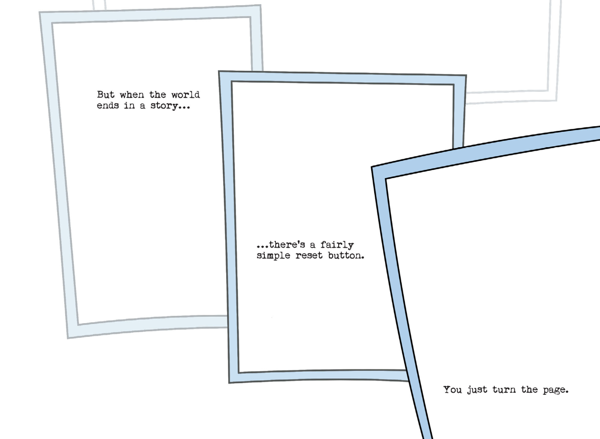
Ish.
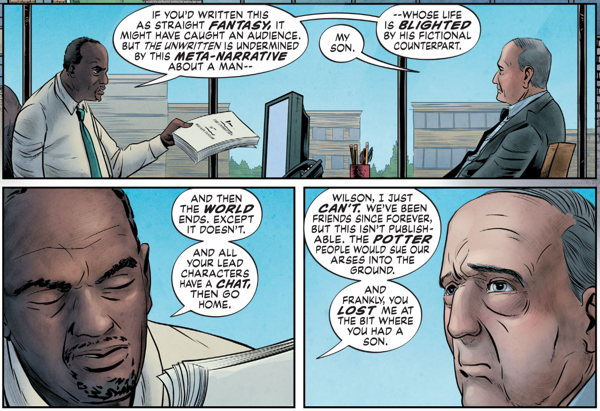
It’s a weird conclusion to a weird story. Fitting that way.
Worth the read.
The Unwritten, Vol. 10: War Stories The Unwritten #10
In the beginning…
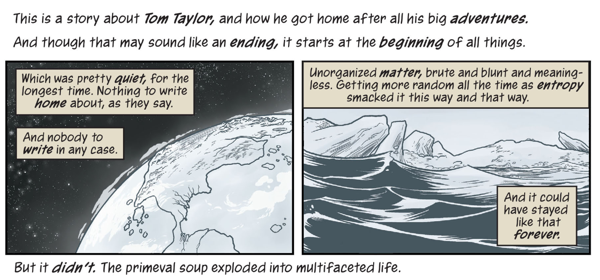
And it only gets weirder from there…
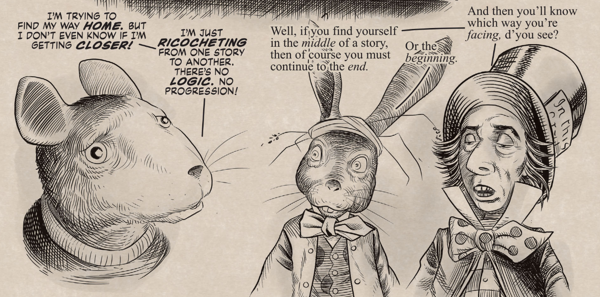
A good choice of story though.
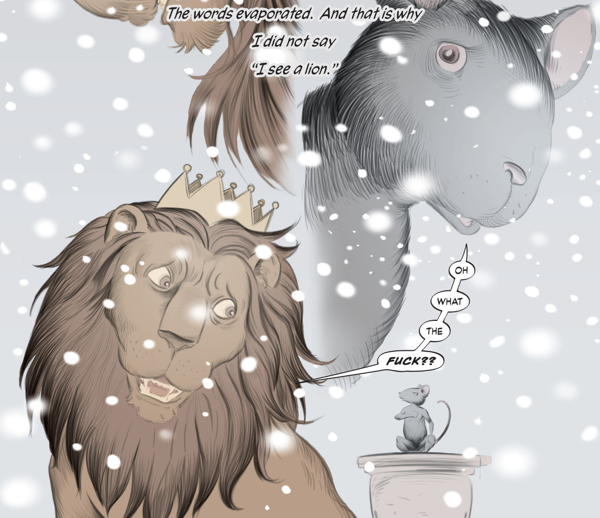
Yup. That’s Aslan.
Of course it’s going to take quite a story to get back to the ‘real’ world from Fables… But in a good way. I’m glad to see a few older characters and more Levithan. Feels like things are really finishing off.
Nettle & Bone
The trees were full of crows and the woods were full of madmen.
The pit was full of bones and her hands were full of wires.
Well that was a delightful surprise–in a dark fairytale kind of way. I’ve not read any T. Kingfisher before, but I’ll have to remedy that.
In a nutshell, Nettle & Bone takes the idea of a fairy godmother’s blessing at birth and twists it, bringing in the politics of unequal neighboring kingdoms; fae, their bargains, and all the twists that go with that; and a touch of demons and death magic. It’s a fun world to build a foundation on.
On top of that, it’s a wonderful cast of characters. I love seeing Marra, third-born princess, sent to a religious order (sort of), and originally on her own to solve the world’s problems. Only for her to collect a motley band of strange and wonderful allies, each in their own ways: a witch, a reluctant godmother, a night, a dog made of bones, and a demon made of chicken. (It makes sense). They’re all great and I love the found family dynamic as they’re off to save the world–or at least some tiny corner of it.
As if that weren’t enough, I love the prose and wordplay. It’s written like a fairytale writ large. It just fits the story so well.
Overall, One of the best books I’ve read this year and more than worth giving it a try.
The Unwritten, Vol. 9: The Unwritten Fables The Unwritten #9
Wait… that Fables. Confused for a bit. Those people all sounded familiar… but not from Unwritten.
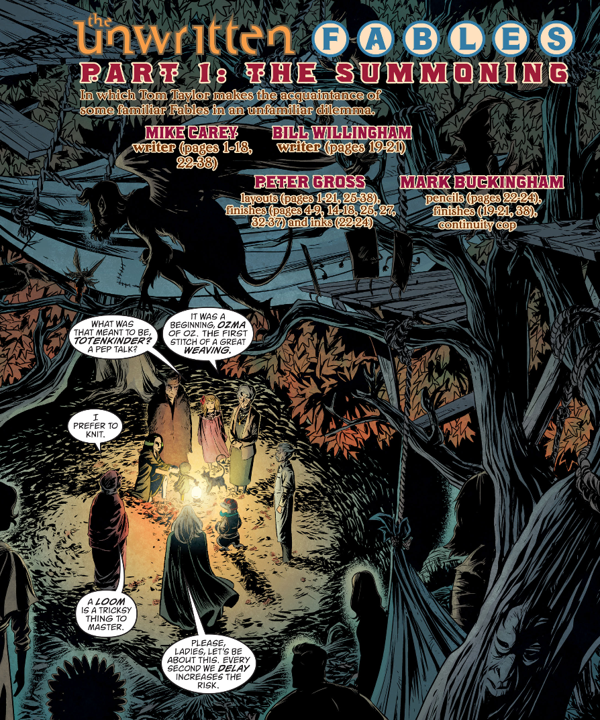
Not at all what I expected, but most appreciated. It’s great to see a number of old faces again, it’s been a while since I read Fables. They fit together about as strangely as you’d imagine.
Onward!
A Declaration of the Rights of Magicians The Shadow Histories #1
Well that’s fascinating bit of historical fantasy. Take revolutionary era France, introduce various relatively ‘common’ classes of magicians (fire, water, weather, mind control, etc), and see what shakes out. It’s an era of history I’m probably not as familiar with as I should be and, while with the introduction of magic things are slightly different, the events actually shake out more or less the same way (as I looked up later). It’s interesting to read about people such as William Pitt and Maximilien Robespierre … and then read about them again in real history.
Call of the Bone Ships The Tide Child #2
The Bone Ships introduced us to the world–where the bones of gigantic sea dragons once provided the building materials for ships, with hints of something even darker and more interesting going on in the background.
Call of the Bones Ships takes up that up another level, really digging more into the often twisted politics and future of the world. It manages to give us quite a bit more insight into Joron Twiner, who is forced rather handedly to come into his own–with whatever that ends up meaning–and torturing him rather much along the way. We also get a lot of more of the gullaime (and the Gullaime specifically). There’s still a lot more to unpack there, so I’m looking for the third.
It ends up being rather a darker book, which fits even better as the successor to the series.
Overall, wonderful worldbuilding, a darker tone, fascinating characters, and worth the re-read. Onward!